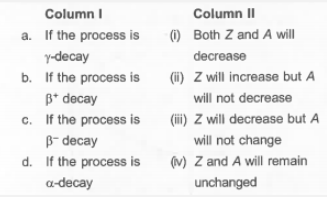In electron capture (radioactive process):
a neutron is formed
a proton is consumed
γ -ray emission take place
X-ray emission takes place
The correct Answer is:A, B, D
Step-by-Step Solution:
1. Understanding Electron Capture:
- Electron capture is a radioactive decay process where an electron from the innermost energy level is captured by a proton in the nucleus.
- This process converts the proton into a neutron, resulting in a decrease in the atomic number of the element.
2. Change in Atomic and Mass Numbers:
- In electron capture, the atomic number (Z) decreases by 1 because a proton is converted into a neutron.
- The mass number (A) remains unchanged since the total number of nucleons (protons + neutrons) does not change; only the type of nucleon changes.
3. Formation of Neutron:
- The equation for electron capture can be represented as:
p+e−→n
- Here, p represents a proton, e− is the captured electron, and n is the resulting neutron.
4. Gamma Ray Emission:
- After electron capture, the nucleus may be in an excited state and can release energy in the form of gamma rays.
- Gamma emission does not change the atomic number or mass number.
5. X-ray Emission:
- X-rays are not directly related to electron capture. They are produced when high-energy electrons collide with a metal target in an X-ray tube.
- This process is distinct from the nuclear changes occurring during electron capture.
6. Conclusion:
- In summary, during electron capture, a proton is consumed, a neutron is formed, and gamma rays may be emitted. The atomic number decreases by one, while the mass number remains the same.
- Electron capture is a radioactive decay process where an electron from the innermost energy level is captured by a proton in the nucleus.
- This process converts the proton into a neutron, resulting in a decrease in the atomic number of the element.
- In electron capture, the atomic number (Z) decreases by 1 because a proton is converted into a neutron.
- The mass number (A) remains unchanged since the total number of nucleons (protons + neutrons) does not change; only the type of nucleon changes.
- The equation for electron capture can be represented as:
p+e−→n
- Here, p represents a proton, e− is the captured electron, and n is the resulting neutron.
- After electron capture, the nucleus may be in an excited state and can release energy in the form of gamma rays.
- Gamma emission does not change the atomic number or mass number.
- X-rays are not directly related to electron capture. They are produced when high-energy electrons collide with a metal target in an X-ray tube.
- This process is distinct from the nuclear changes occurring during electron capture.
- In summary, during electron capture, a proton is consumed, a neutron is formed, and gamma rays may be emitted. The atomic number decreases by one, while the mass number remains the same.
Similar Questions
A Geigger Muller counter is used to study the radioactive process. In the absence of radioactive substances A, it counts 3 disintegration per second (dps). At the start in the presence of A, it records 23 dps, and after 10m in 13dps,
i. What does it count after 20m in ?View SolutionWhich of the following is/are correct when a nuclide of mass number (A) and atomic number (Z) undergoes radioactive process?
View SolutionWhen nucleus of an electrically neutral atom undergoes a radioactive decay process, it will remain neutral after the decay if the process is
(a) An α- decay (b) Aβ⊕-decay
(c ) Aγ-decay (d) AK- capture processView SolutionWhen nucleus of an electrically neutral atom undergoes a radioactive decay process, it will remain neutral after the decay if the process is
(a) An α- decay (b) Abete⊕-decay
(c ) Aγ-decay (d) AK- caputure processView SolutionMatch the column in radioactive decay process of nucleus with atomic number Z and mass number A.
 View Solution
View SolutionCu64( half life=12.8hours) decay by βc−− emission (38%),β⊕− emission(19%), and electron capture (43%). Write the decay products and calculate partial half lives for each of the decay processes.
View Solution.40K is an unusual isotope, in that it decays by negative beta emission, positive beta emission, and electron capture. Find the Q values for these decays.
View SolutionWhy is oxygen necessary for the operation of the electron transport process?
View Solutionfor the β+ (positron) emission from a nucleus, there is another competing process known as electron capture. Electron from an inner orbit (say K shell) is captured by the nucleus and neutrino is emitted. Show that if β+ emission is energetically allowed, electron capture is necessarily allowed but not vice -versa.
View SolutionA radioactive nuclide emits γ-rays due to
a. K-electron capture
b. Nuclear transition from higher to lower energy
c. Presence of greater number of neutrons than protons
d. Presence of greater of protons than neutronsView Solution

